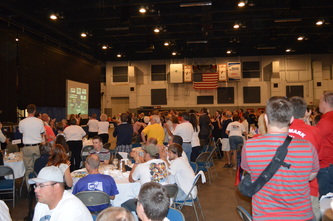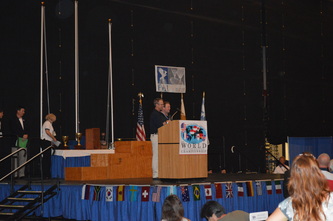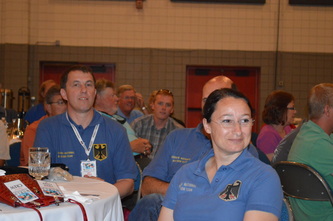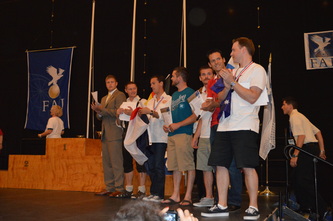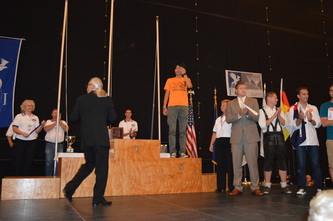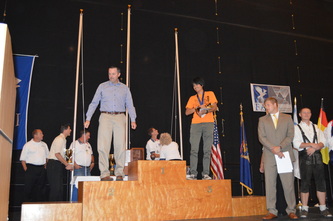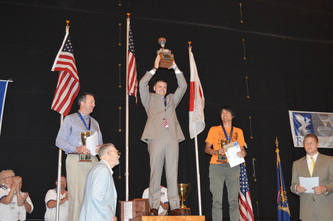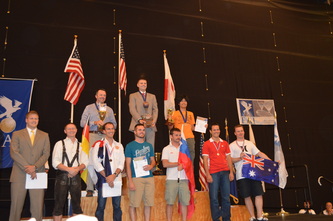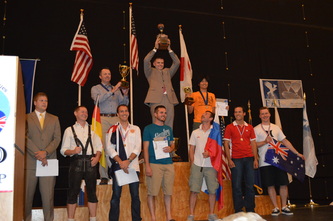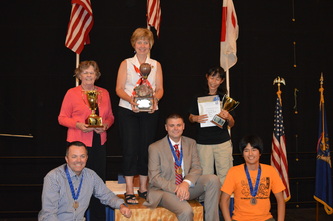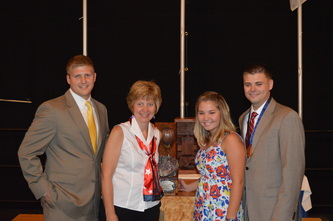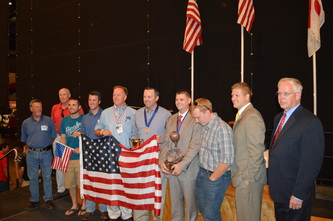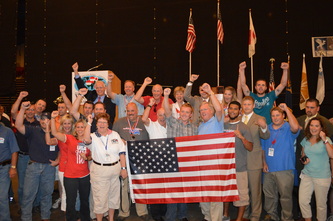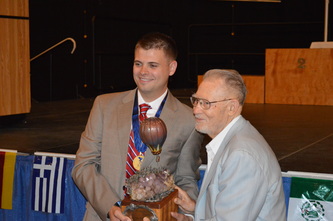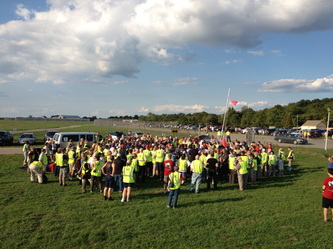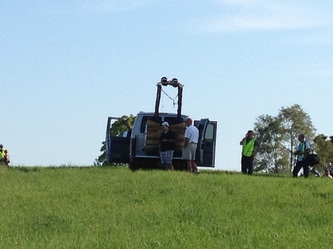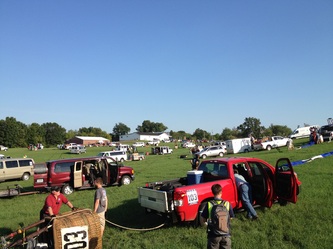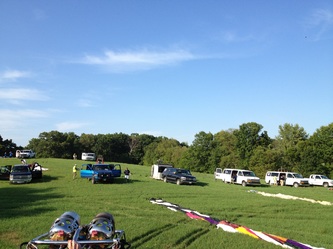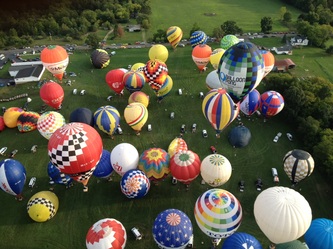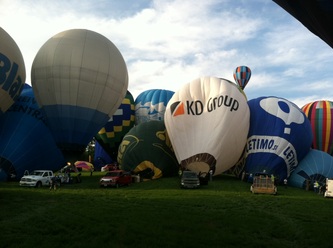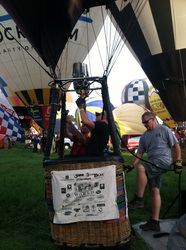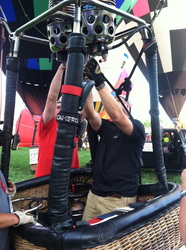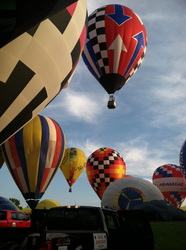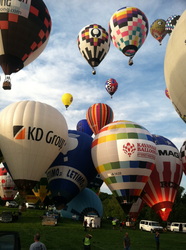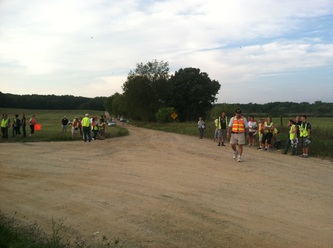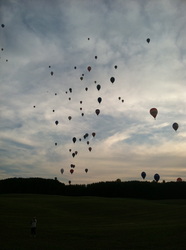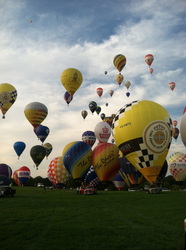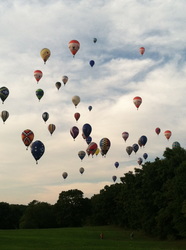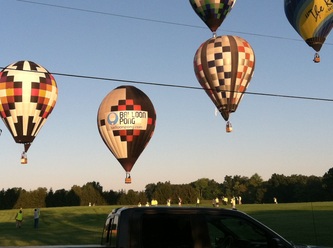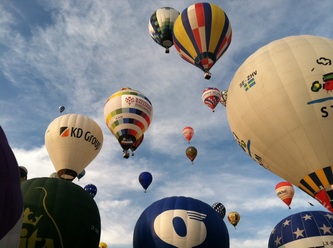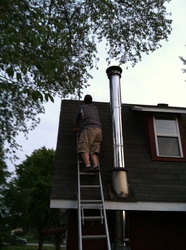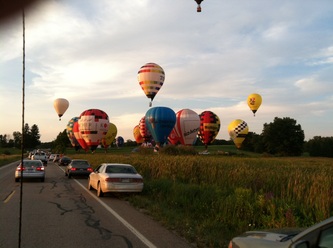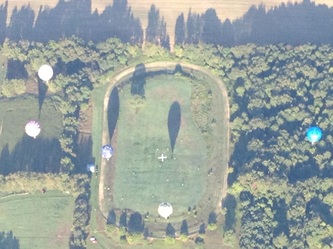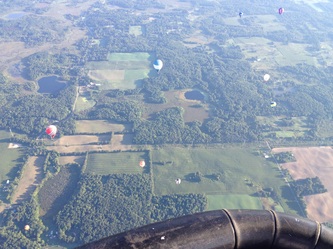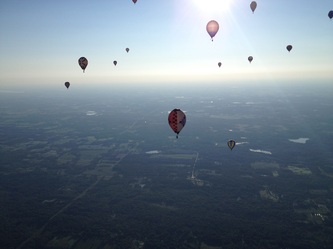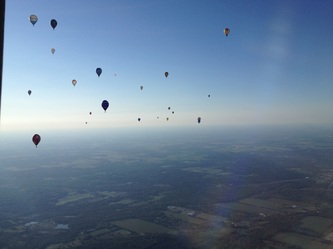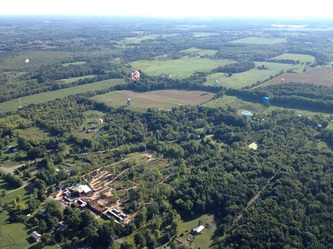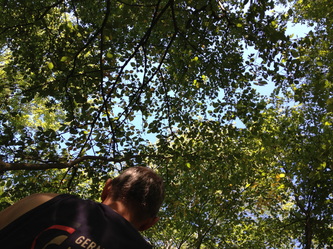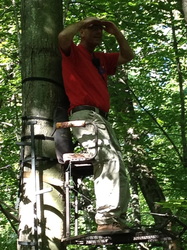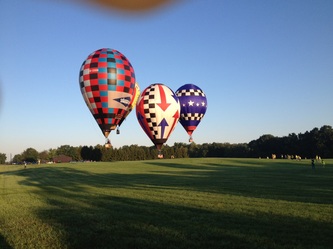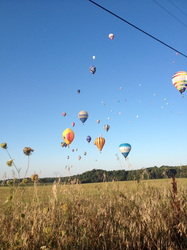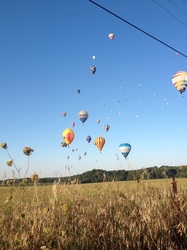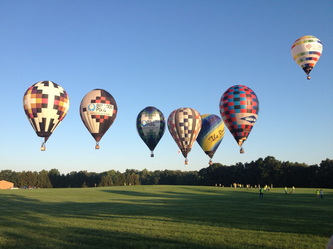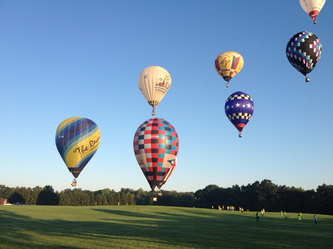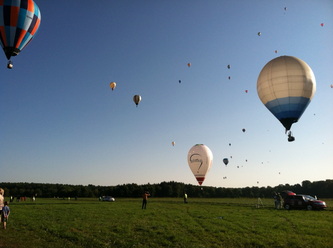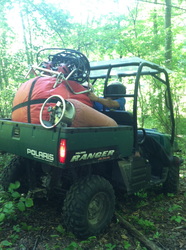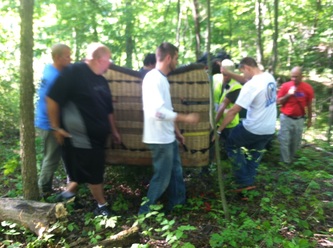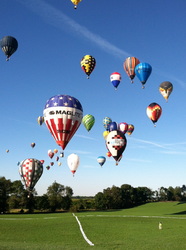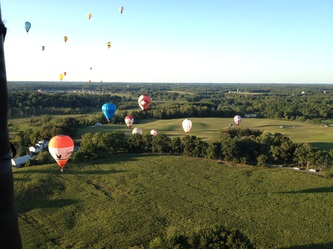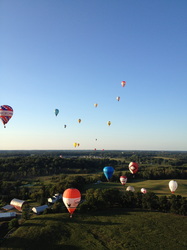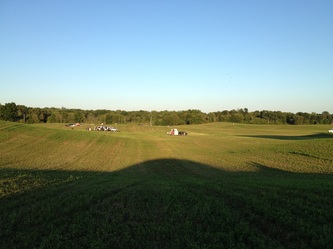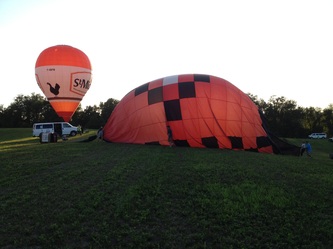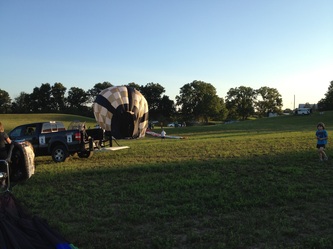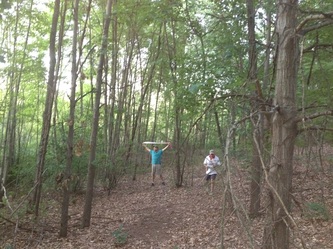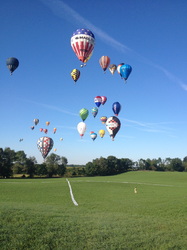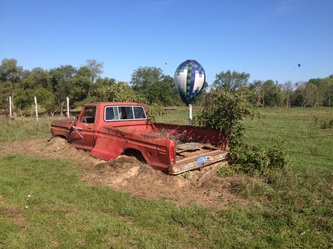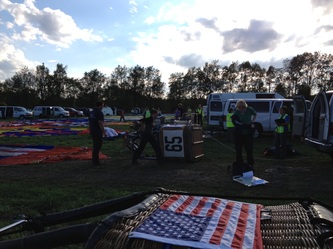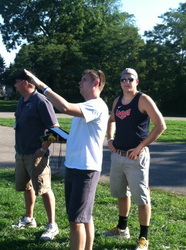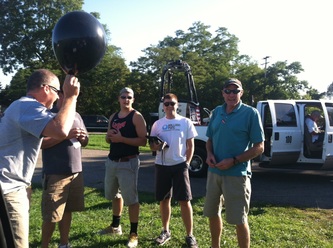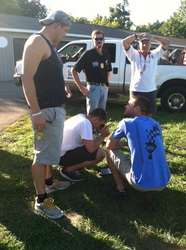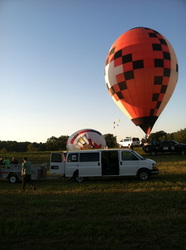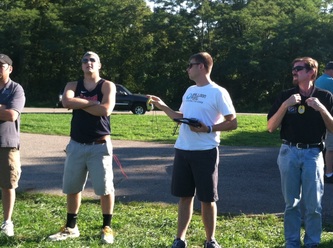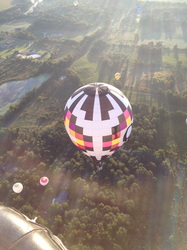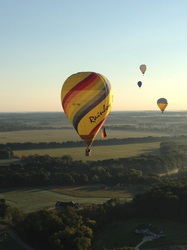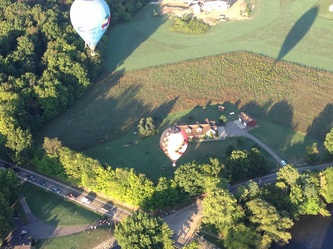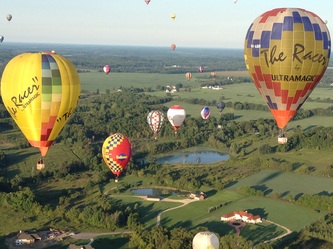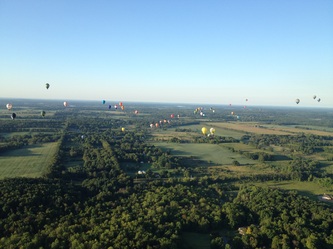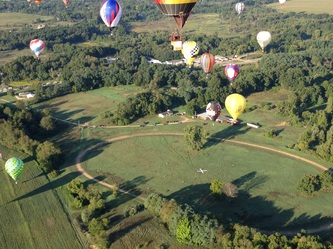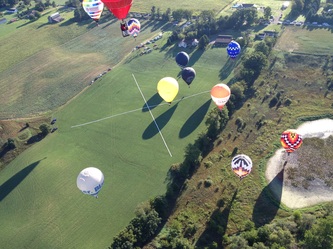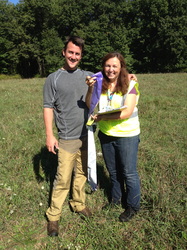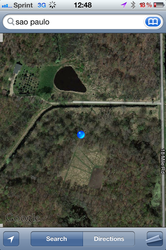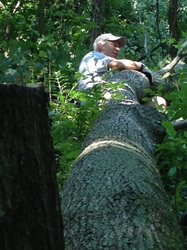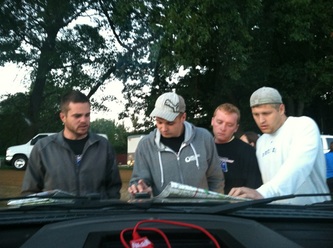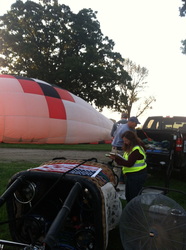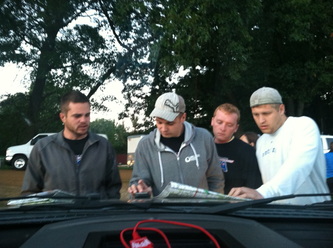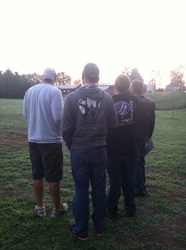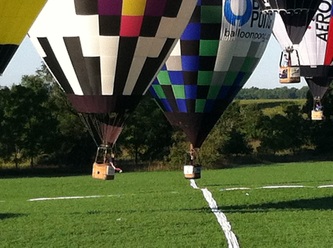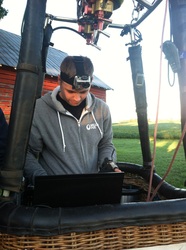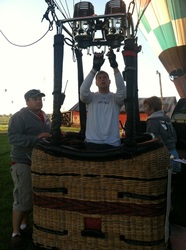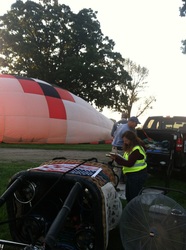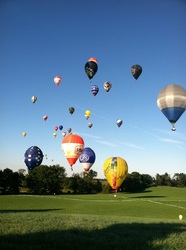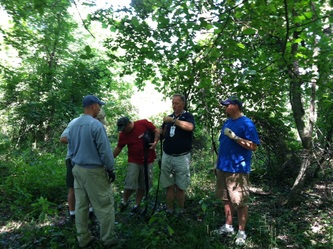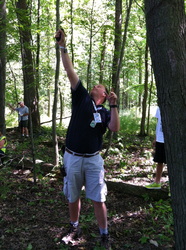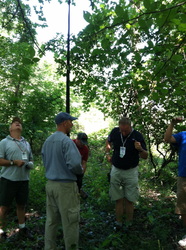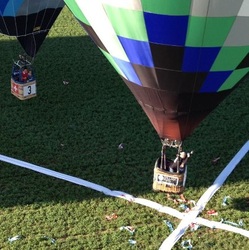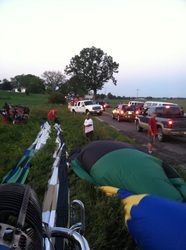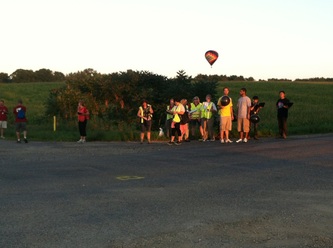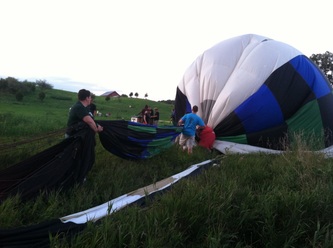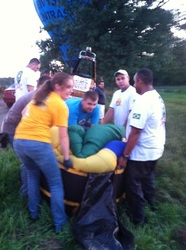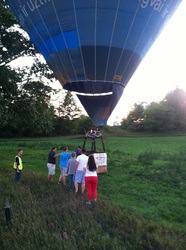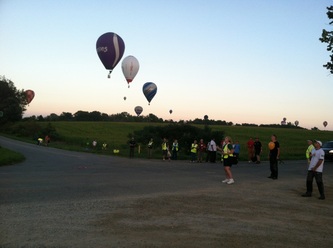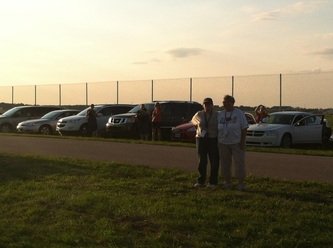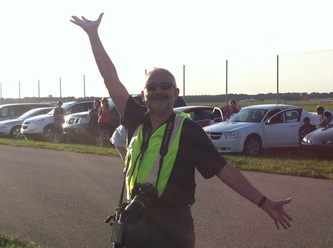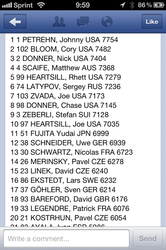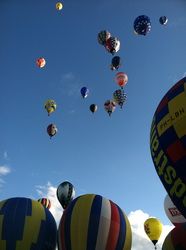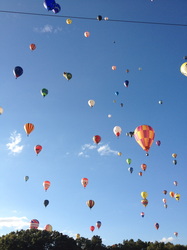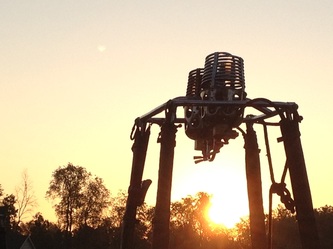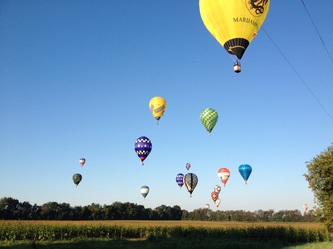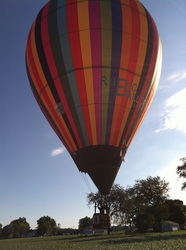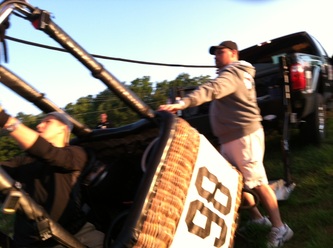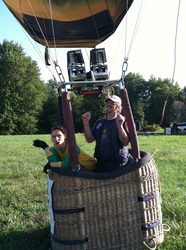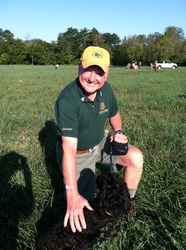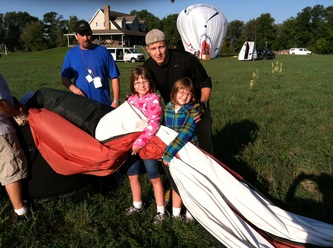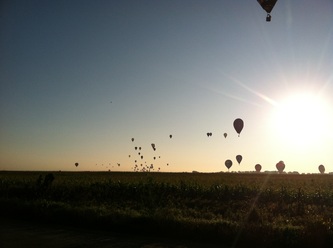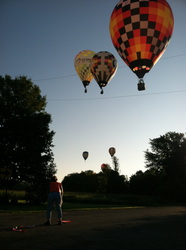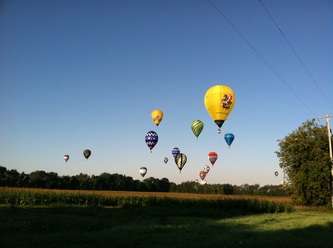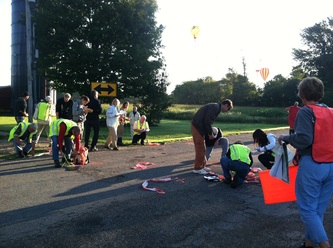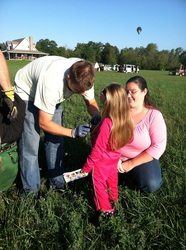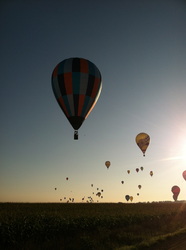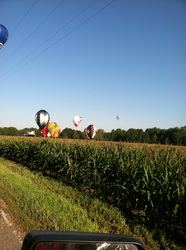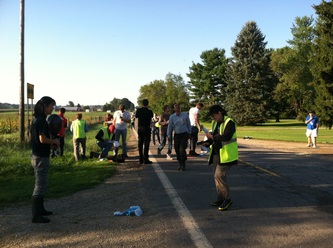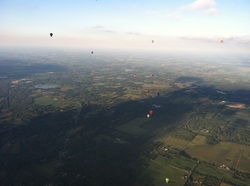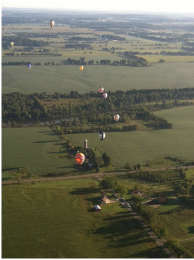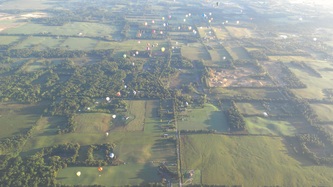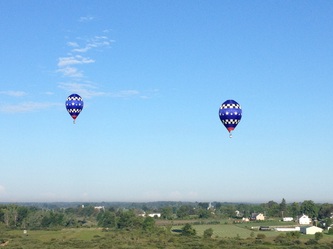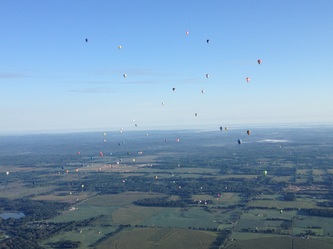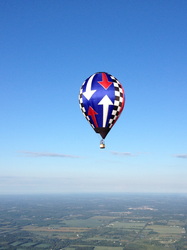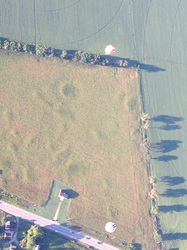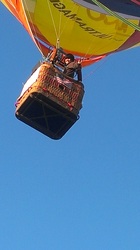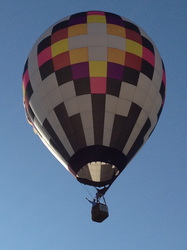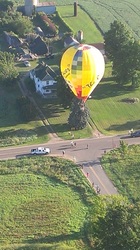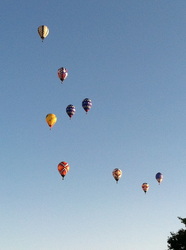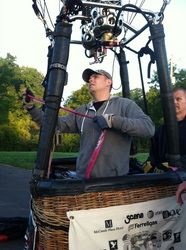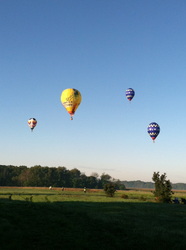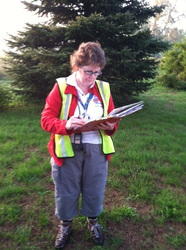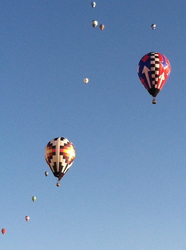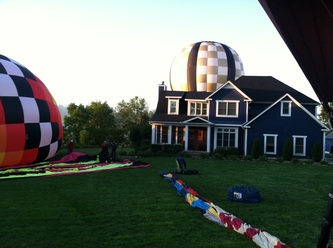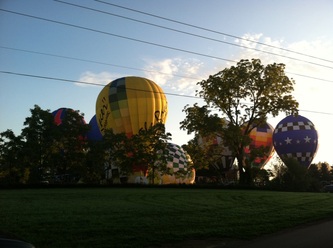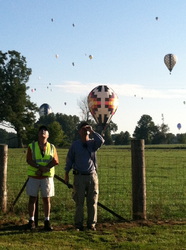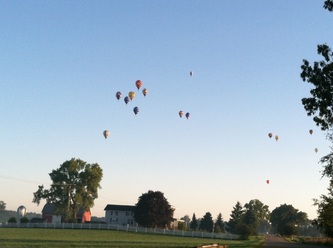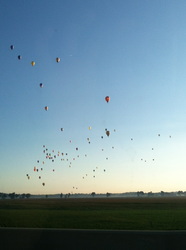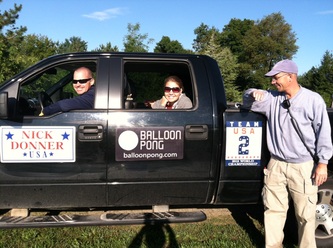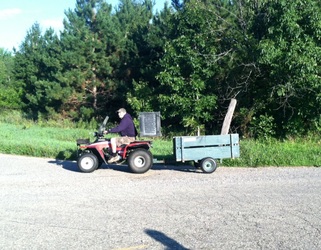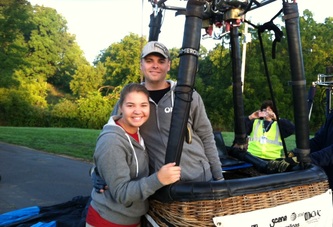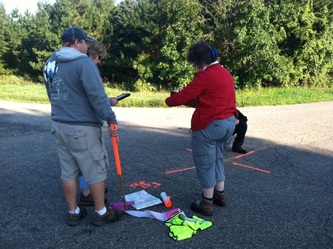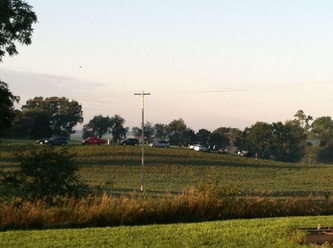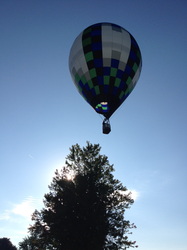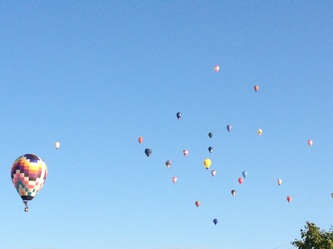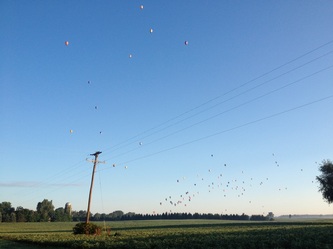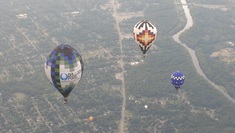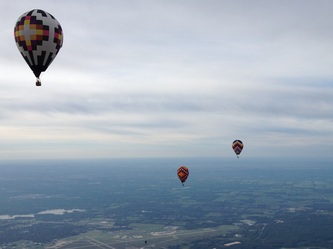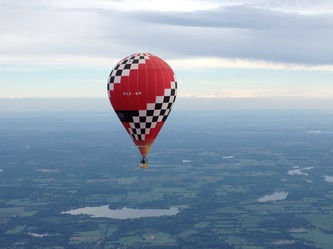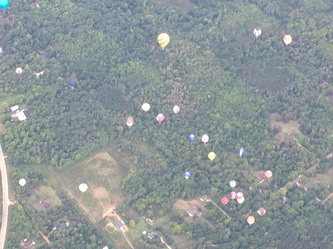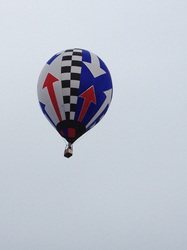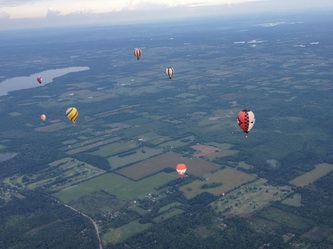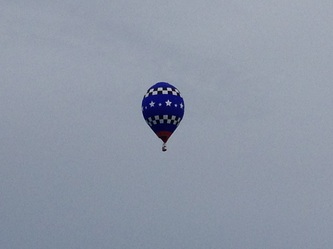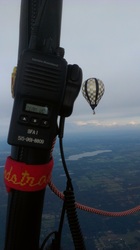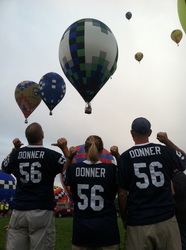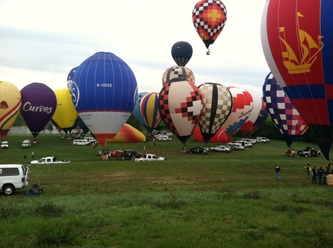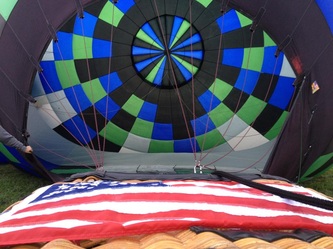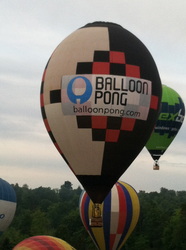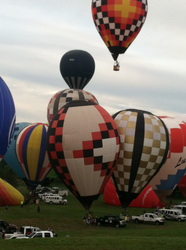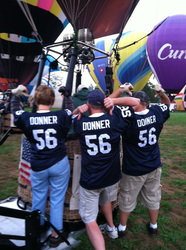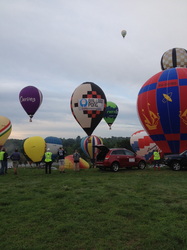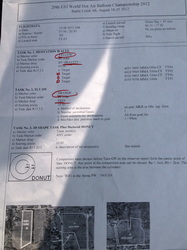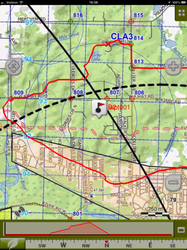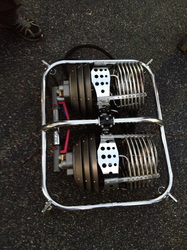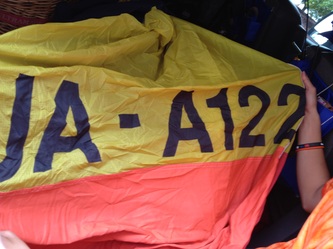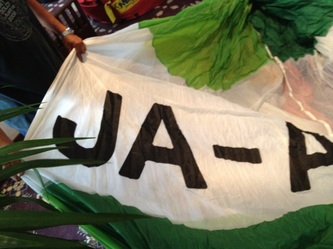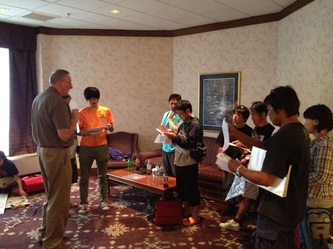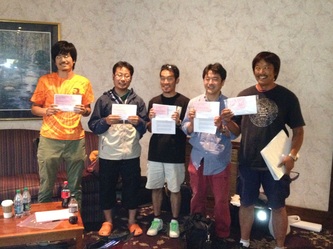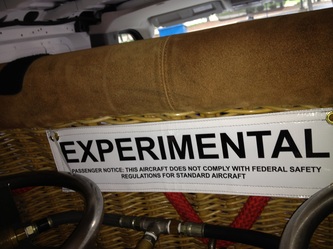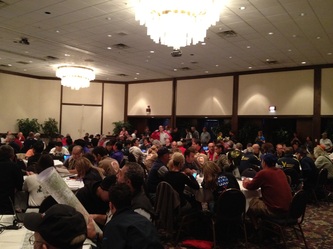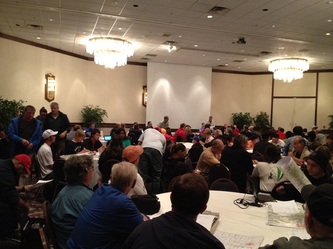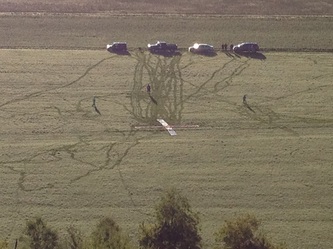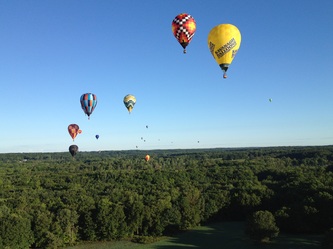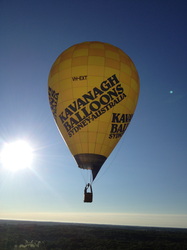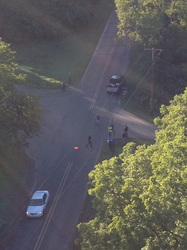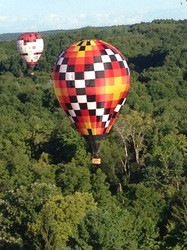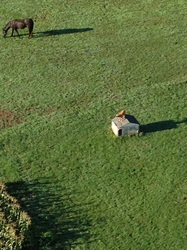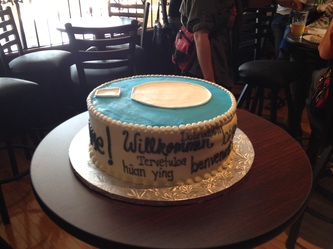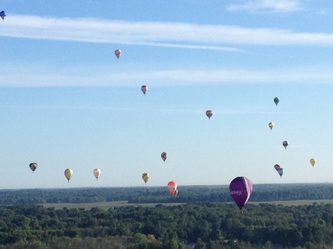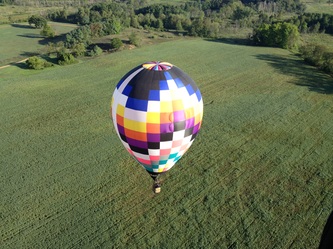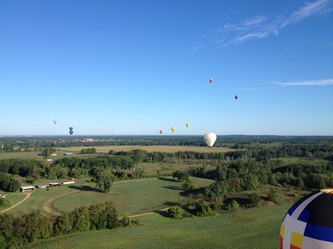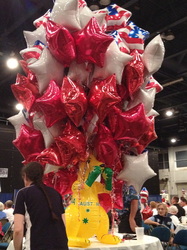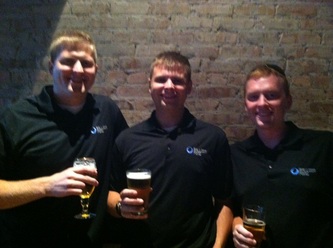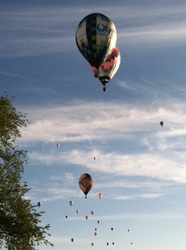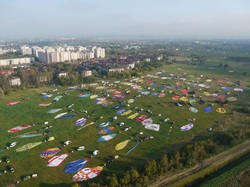world championship
Battle creek, mi USA
2012
Award CeremonyAfter a long week of intense flying and competition the event was concluded with a Closing Award Ceremonies. The almost four hour long ceremony featured a local concert band set, recognition of well deserved event committee staff, the passing of the FAI flag to the Brazilian hosts of the 2014 Championship, and finally the presentation to top ten competitors.
See everyone in Brazil 2014! Friday Morning - Flight #10 BalloonPong Headquarters
Three tasks for the final flight of the 20th FAI World Hot Air Balloon Champioship: Fly In, Hesitation Waltz, Hesitation Waltz. Competitors saw the most speed they have had throughout the weeklong competition, but a weak inversion kept most of the speed above the surface level allowing for some great winds for competition.
The first task was at a local church commonly used for targets in Battle Creek over the years, the second was just at the top of a hill where competitors had to fly in to the target blind before being able to dip down low to drop at the "X". The third target of the morning, and 30th of this Championship, was at CLA-4, which was used for a takeoff site and target area throughout the week so competitors were familiar with this area. Quick winds with reliable steerage made it very competitive this morning for tasks and to move up pilots had to take dead aim at the targets. All three were "free drops", meaning they could wind up baggies and throw them as far as they like. We are still waiting on scores for all three targets, but for the most part tasks one and two saw very good scores. The third task proved to be more difficult for pilots to reach, but there were still some good scores. Most of the field, however, was outside the MMA of 100 meters. At this point all complaint and protest periods have been suspended until 8:00 AM tomorrow morning. Results through 27 tasks have been posted and Nick Donner has the lead. After a strong showing again Friday morning it seems as if he will retain the lead and win his first World Championship. We'll update you as more scores become available. Thursday Evening - Flight #9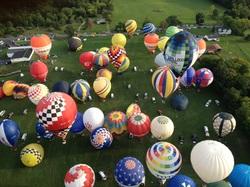
Event Director, David Levin, called two tasks for competitors this evening; a Hesitation Waltz and Pilot Declared Goal. Pilots were instructed to head towards the common launch area to begin preparations for flight and to make their declarations at the appropriate signal point.
Once on-site, at CLA-8, a supplemental briefing was called where Levin amended the task sheet to make task 26 a Pilot Declared Goal rather than a Hesitation Waltz. In sum, competitors had two PDG's to fly Thursday evening. On the first pilots were only allowed one goal to choose from and at the second they could declare two goals and throw within 100 meters of the center to whichever one they ended up closer to. Fickle winds made it difficult early to determine how to approach the first PDG, but prevailing upper level winds finally proved to allow for plenty of Easterly winds and some steerage came into play. The only issue was that to find the right hand (Easterly) turn pilots had to climb to almost 5,000 ft MSL - typically within a close distance to their goal. With a 100 balloon field it always is amazing how many pilots were able to place their baggies close to these goals. Thursday evening was no different as there were lots of good results on each task. It sounds like Nick Donner will likely maintain his lead atop the field and Yudai Fujita should be close behind. Weather Officer, Brad Temeyer, gave a rough forecast of Friday morning and cautioned that a low level jet could develop that might put the flight in jeopardy. Stay tuned to see the conclusion of the event. Thursday Morning - Flight #8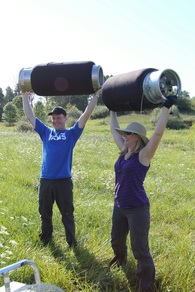 Andrew Robertson with empty tanks!
The flights are really starting to pile up. We flew another four tasks this morning, bringing the total to 25 tasks with two scheduled flights remaining. We look almost certain to end the Championship at or near the 30 task mark. Through 21 tasks Nick Donner of the USA has taken the overall lead.
Four tasks this morning included a Fly-In, Judge Declared Goal, Judge Declared Goal, and Land Run. Winds were more brisk this morning than they have been at any other point during the Championship. Pilots saw speeds in excess of 30 kilometers an hour above 1,400 ft MSL. Pilots flew into roughly the same target area as Wednesday night, but a slight change was used to place pilots in the front field of the complex. It looks as if the first of three gravity drops was the toughest. There were a bunch of good scores and a bad result on the Fly-In could prove to be costly. After dropping at the first target pilots then ascended to 5,000+ ft. MSL in search of winds that would take them to the South. This cycle would continue throughout the flight two more times. Judging at what point to descend from altitude was difficult but again lots of great scores were seen on the first Judge Declared Goal of the morning. The last Judge Declared Goal was a bit more difficult to hit because of the angle needed to be obtained to get from the 2nd to the 3rd target of the morning. Scores were noticeably worse on the last gravity marker drop when compared to the others, but still there were a handful of baggies within the legs of the "x". After the third task pilots had to fly a Land Run. For this task the rules called for pilots to declare their center point to their observer before take-off along gridline 6000. The object of a Land Run task is to create a triangle with the largest area possible. In this case pilots were restricted to a three kilometer ring around their center point. Once a pilot entered the ring, they established point A. Point B was the greatest difference in track between Point A and the pilot's exit, Point C. Wednesday Evening - Flight #7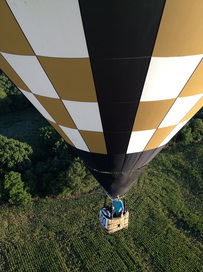
The great weather continued tonight for the 20th World Championship. Two more tasks were called: Hesitation Waltz and Hesitation Waltz. These were the more traditional style HWZ's as there were two measuring areas in one of the common launch areas just a few hundred meters apart and the second set of HWZ's were located almost two kilometers from the first and in different fields.
Many competitors took off in a large field just to the Southwest of the first HWZ and fly in relying on lower level winds at just over a kilometer out. This made it difficult to maneuver and those pilots were more subject to surface level winds. Earlier balloons seemed to be able to take advantage of higher winds at about 5,000 ft MSL and get close to the second set of HWZ goals, while later balloons didn't seem to have as much turn. At the end of the night it was pretty hard to tell who and how many pilots did well. There were roughly 20 baggies scored in the MMA on the first set of HWZ goals and less on the second set of goals. We are now waiting to see results on 7 more tasks so stay tuned to see how things are panning out. Wednesday Morning - Flight #6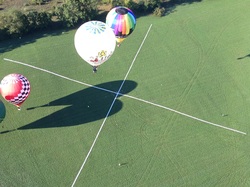 MNDD from 600ft
Five tasks for competitors this morning in Battle Creek. Tasks were a Pilot Declared Goal, Judge Declared Goal, Minimum Distance Double Drop, Elbow, and finally a Fly-On. Weather conditions were pretty good for the tasks called, but maximum speed of 15 kilometers an hour made it a bit difficult for pilots to reach all the goals in the 3 hour flight window. Winds flowed generally from the Southwest to Northeast and pilots took off with almost 100 degrees of steerage in the bottom 1,000 feet above ground level.
Scores were pretty tight at task 15 (PDG) but it was fairly difficult to judge just how much right turn was to be had along the tree-top level winds. In the end, it took a score of under a meter to wind the task. Low and slow winds made the trip to the Judge Declared goal (only 4 kilometers away) take about 25-30 minutes and once there pilots had the option, depending on their approach, to play in the surface winds or set up for a more direct approach to the gravity marker drop. Again, good scores were seen at this goal but typically by the pilots who were later in the flight as there was a surface left that developed and, although slow, aided pilots in getting very close. By the time pilots made the move towards the Minimum Distance Double Drop (located at CLA-5) it was apparent that time could become an issue with two more tasks still to complete. Even still, many balloons hung low searching for just the correct wind to take them over the Minimum Distance at the center point so they could obtain the best result possible. Lots of great scores were recorded at the Minimum Distance but it will prove to be very important to just have a result regardless of whether or not you recorded perfect scores. Task 18, an Elbow, required pilots to fly two kilometers from point A, which was the crossing of East-West gridline 8800, to establish point B. Point C, was the point where competitors reached two kilometers from point B. A perfect result would be to have Point C cross directly over Point A. It turns out the best strategy was to travel roughly two kilometers to the North from Point A and then to climb to 8,000 ft. MSL to carry out the last two kilometers at altitude. Pilots were challenged with time and the last thirty or so balloons in the field had to quit on the Elbow to try and get somewhere close to the final task, a Fly-On. The Fly-On was a race again the clock for most. All scoring ended at 10:00 local time and many pilots were still hundreds of meters, if not kilometers from their goals. A clear advantage was to those pilots that were out early as they had more time to complete their tasks. Five tasks should mean another significant shake up in the standings but it looks to be Americans Johnny Petrehn and Nick Donner starting to rise to the top. Tuesday Evening - Flight #5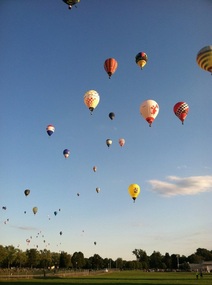
Another evening at the World Championships and another two tasks for competitors. Event Director, David Levin, initially called a 3DT (Donut Shape) and a HWZ. The 3DT was changed to a Pilot Declared Goal at the Common Launch point via a supplemental briefing. Brisk winds challenged competitors a bit when inflating at the W.K. Kellogg airport on the West side of Battle Creek.
The PDG had to be along gridline 8200 and the point was located at 2,000' MSL. There are potential issues any time you call a virtual task with as many balloons as we have flying this week in Battle Creek and this evening's flight was no exception. Much like Monday evening's congestion, pilots were again flying recklessly in an effort to make drastic maneuvers in a short time frame to get to the 2,000' MSL mark. Results will vary based upon altitude and track but several good results have been reported. The Hesitation Waltz, like this morning, again wasn't your traditional Hesitation Waltz. Pilots were allowed to select any of the valid intersections goals South of I-94 (freeway) and as long as they flew within 100 meters of any goal they could achieve a direct measure result. I'm officially dubbing this task the "blind squirrel" task. In America we have a saying that even a blind squirrel finds a nut every once in a while and having this type of task allows pilots that might not have otherwise made a goal the opportunity to achieve a good result by accidentally flying over a valid intersection. These "blind squirrel" tasks are not competitive and have no place in a World Championship, but they now make up more than 20% of all tasks called to this point. There are surely great scores on this task. Until next time... Tuesday Morning - Flight #4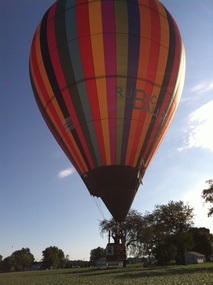
Three tasks this morning in Battle Creek, MI (well really it was nearby Marshal, MI). Levin called a CRAT, Hesitation Waltz, and Hesitation Waltz. The CRAT is an oft unused task but always provides great challenges for competitors. Winds were out of the Northeast turning more out of the North as pilots ascended through the first 1,000 feet above ground level.
The CRAT featured three scoring areas: A, B, and C. Each scoring area had point where a pilot could achieve the best result and win the task, but the scoring areas changed every ten minutes. The challenge was to make an approach on an area that you felt that you would definitely be able to get a score in. Several pilots were caught making an approach to an area that closed before they could get a marker on the ground. In the end, numerous baggies were placed close to the pavement in all scoring areas so results should be tight. After the CRAT, pilots had the use of the entire competition area West of the 6800 gridline to find a valid goal and place a baggie within 100 meters. This repeated for the final task (12) of the flight as well, needing just 1 kilometer in between goals. Pilots were able to treat this essentially as a Fly-On, Fly-On scenario and as a result scores were very good at most intersections. It is still too early to tell how the scores are going to shake out through 12 tasks as scoring has been lagging behind task calling. Just this morning the Official results through task 7 were released and the top six spots were held by Americans. Look for a shakeup in the standings as last night's flight (tasks 8 and 9) have yet to be included in the overall scores as well as 10, 11, and 12. Scores should likely be up to date by the time the evening briefing rolls around because all the scoring this morning was limited, meaning no GPS logger results were made.
|
Links |
FAA doesn't allow Japanese pilots to fly JA registered balloons
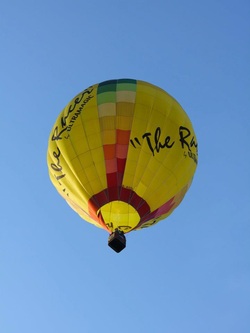
Monday the FAA made the final, final determination that they would not be allowing JA (Japanese) registered balloons to fly in the United States back pedaling from a previous agreement that would have allowed for an exemption for both the pilots and balloons to fly in Battle Creek this next week.
The fix for the problem has been BalloonPong Enterprises, LLC purchasing all five balloons the Japanese have shipped over and registering them in the United States. These balloons are receiving an FAA inspection to guarantee airworthiness and N-numbers after countless hours of paperwork by Maury Sullivan and his group in Battle Creek. The pilots will also require a US student pilot certificate so that they are legally able to fly US registered balloons and fly in the US.
This has been a long process that is coming to the final hour. The FAA still must approve the paperwork that is being overnighted to Oklahoma City for their oversight. Though the registration office has cooperated and promises a quick process in their office this entire ordeal should never have happened.
Admittedly this is both the fault of the US FAA and the Japan Balloon Association. The JBA is not recognized in Japan or ICAO and therefore Hot Air Balloons are not technically recognized as aircraft in Japan. Because of this even though the balloons are maintained per the flight manuals for the individual balloons the FAA was not willing to fulfill their end of things and grant the waiver for the pilots and balloons.
BalloonPong was happy to help and think that had the roles been reversed in any country the host would have done anything possible to allow our fellow competitors to fly. Hopefully the last remaining issue concerning the Japanese being required to fly solo will be worked out so that all flights are solo flights and no competitive advantage is given to anyone.
For more information please read Trace Christenson's article here.
The fix for the problem has been BalloonPong Enterprises, LLC purchasing all five balloons the Japanese have shipped over and registering them in the United States. These balloons are receiving an FAA inspection to guarantee airworthiness and N-numbers after countless hours of paperwork by Maury Sullivan and his group in Battle Creek. The pilots will also require a US student pilot certificate so that they are legally able to fly US registered balloons and fly in the US.
This has been a long process that is coming to the final hour. The FAA still must approve the paperwork that is being overnighted to Oklahoma City for their oversight. Though the registration office has cooperated and promises a quick process in their office this entire ordeal should never have happened.
Admittedly this is both the fault of the US FAA and the Japan Balloon Association. The JBA is not recognized in Japan or ICAO and therefore Hot Air Balloons are not technically recognized as aircraft in Japan. Because of this even though the balloons are maintained per the flight manuals for the individual balloons the FAA was not willing to fulfill their end of things and grant the waiver for the pilots and balloons.
BalloonPong was happy to help and think that had the roles been reversed in any country the host would have done anything possible to allow our fellow competitors to fly. Hopefully the last remaining issue concerning the Japanese being required to fly solo will be worked out so that all flights are solo flights and no competitive advantage is given to anyone.
For more information please read Trace Christenson's article here.

